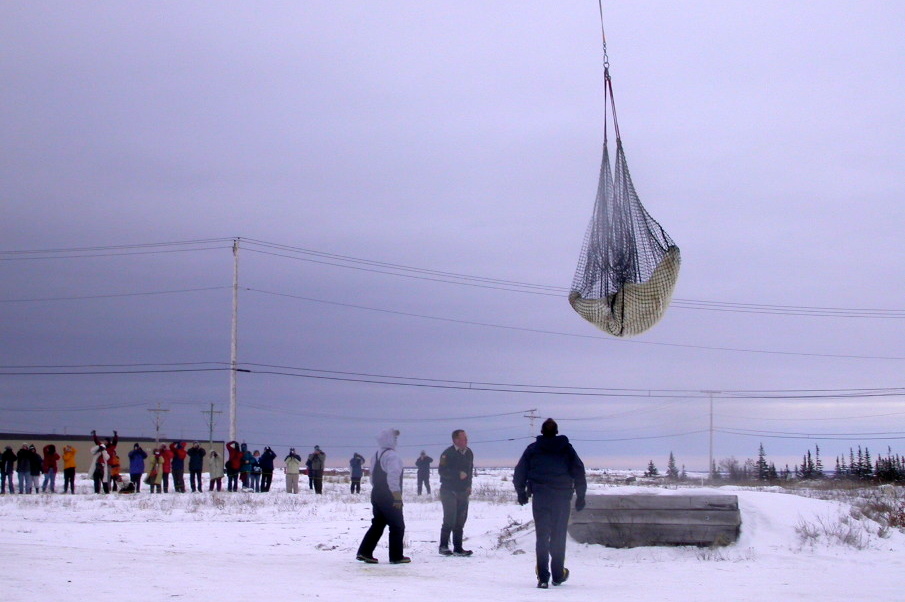“A Tranquilized Polar Bear Rising Through an Autumn Sky”
And other new songs about endangered species.

Courtesy of Nick Miroff
I’ve known Chris Funk of Black Prairie since 2003, when his other band, the Decemberists, was just starting to take off. By the time I started work on my new book, Wild Ones, in 2010, Chris and several other of the Decemberists had formed Black Prairie. We talked about collaborating somehow—about the band writing a “soundtrack to the book”—though, frankly, I don’t think either of us really knew what that actually meant. (The book is about quixotic human efforts to save the polar bear, the whooping crane, and an obscure butterfly.) As the band members read the book, though, they started sending me ideas for songs based on characters and scenes, and I was amazed at how the music actually recreated some of the moods and emotions I felt while reporting the book—living through those scenes and hanging out with these people. The result is Black Prairie’s extended EP, WILD ONES: A Musical Score for the Things You Might See in Your Head When Your Reflect on Certain Characters and Incidents That You Read About in the Book. The album comes out on May 14. Below, I've explained how four of the songs were inspired by scenes and characters from the book, including William Temple Hornaday, the taxidermist-turned-conservationist who is the subject of my latest Slate essay. If you like what you hear, you can stream the whole album at the bottom of this page.
“A Tranquilized Polar Bear Rising Through an Autumn Sky”
The town of Churchill, Manitoba is a shivering little settlement on the edge of Hudson Bay that, every fall, gets overrun with about 900 polar bears and 10,000 polar bear tourists. Polar bears routinely wander into town—they especially love hanging out by the elementary school. When they do, folks call 675-BEAR and a squad of bear patrol officers tries to herd the animals back onto the tundra, firing off pyrotechnics and noise-makers. Bears that won’t budge are tranquilized and transferred to a Quonset hut near the airport, a facility sometimes referred to as the “Polar Bear Jail.” Each bear serves a month sentence—enough to dissuade it (hopefully) from entering town again—then it’s drugged again, packed in a net, and airlifted under a helicopter to a safer area north of town while crowds of tourists gather to watch. It’s a breathtaking thing to see: a polar bear lifting off the ground and flying away.
“Flight of the Forgotten Metalmarks”
The critically endangered Lange’s metalmark butterfly lives exclusively on a scrap of weedy land outside Sacramento, Calif., called the Antioch Dunes. The property is surrounded by a waste transfer station, a sewage treatment plant, and a diner called the Red Caboose—a converted Santa Fe railroad car popular with bikers. A giant wallboard factory sits in the middle, splitting the refuge in two. Once, a U.S. Fish and Wildlife Service employee told me, they found the body and head of a dead pig in two separate black garbage bags, dumped at the refuge’s front gate.
I set out to trace the changes at that one specific piece of land over the last 150 years: how sand that once piled there spectacularly was all trucked away and the ecosystem unraveled; and how humanity gradually hemmed in the little encampment of butterflies. In our imaginations, butterfly habitat is always a pretty place on a beautiful day. But somehow, the Lange’s metalmark has persisted in Antioch—just barely.
“Dawn Departure, Jefferson County”
The nonprofit Operation Migration teaches endangered whooping cranes to migrate by training them to fly behind small, ultra-light airplanes. Every fall, the group leads a cohort of cranes from Wisconsin to Florida, stopping for the night every 25 or 50 miles. It’s a sluggish, sometimes maddening way to travel, and the year I happened to tag along was even harder on the pilots, and more disheartening, than most. Disagreements within the partnership of nonprofits and government agencies that oversees the whooping crane recovery were coming to a head, threatening to tear the project apart. These disagreements were scientific—about birds—but also fiercely interpersonal—a clash of all too human personalities.
The migration’s final leg runs from Jefferson County, in the Florida panhandle, to the St. Marks National Wildlife Refuge, where the birds will live all winter. I watched it unfold from the back of a Cessna, 500 feet above the planes and cranes, looking down on Jefferson County’s patchwork of pastures and pine forests. Given the bureaucratic disarray and uncertainty mounting around the project by then, there was something both melancholy and incredibly dignified about the scene—about witnessing the pilots lug themselves into the air at dawn, once again, to finish the job and get the birds home. They’d started the journey in October. It was almost Christmas now.
“Dear Sir. Most Sincerely, William Temple Hornaday”
William Hornaday was a renowned taxidermist, the first director of what would become the Bronx Zoo, and a tireless member of the Victorian-era conservation movement. Click here to read my Slate essay on Hornaday’s unlikely role in saving the American Buffalo.
Stream the whole album here: